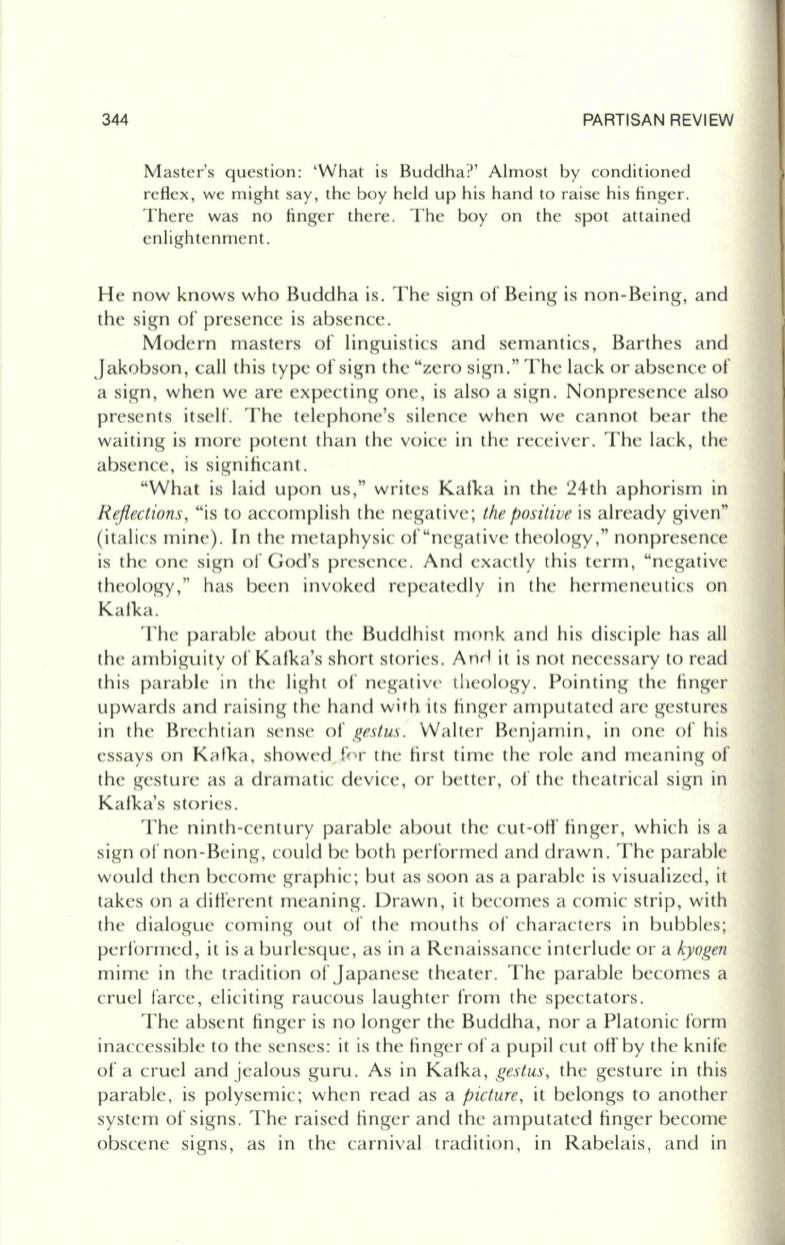
344
PARTISAN REVIEW
Master's question: 'What is Buddha?' Almost by conditioned
reflex, we might say, the boy held up hi s hand to raise his finge r.
T here was no finger there. T he boy on the spot attained
enli ghtenment.
H e now knows who Buddha is. The sign of Being is non-Being, a nd
the sign of presence is a bsence.
Mode rn mas te rs of lingui sti cs and sema nti cs , Ba rthes a nd
J akobson , call this type of si gn the "zero sign ." The lack or a bsence of
a sign , whe n we a re expecting one, is also a sign . Nonpresence also
prese nts itself. The telephone's silence when we cannot bear the
wa iting is more potent tha n the voice in the rece iver. The lack , the
absence, is signifi cant.
"Wha t is la id upon us," writes K a fk a in the 24th a phorism in
Reflections,
"is to accompli sh the negative;
the positive
is already given"
(ita lics mine) . In the meta phys ic of "negati ve theology," nonpresence
is the one sign of God's presence. And exactly thi s term , "negative
theology ," has bee n invoked repeatedl y in the he rmeneutics on
K a fk a.
T he pa ra ble a bout the Buddhist monk a nd hi s disc iple has all
the ambi guity of K a fk a's short sto ri es. Anrl it is not necessary to read
thi s pa rable in the li ght o f negative theology . Pointing the finge r
upwa rds a nd ra ising the ha nd with its finge r amputa ted a re ges tures
in the Brechti a n sense of
gestus.
Wa lte r Benj amin , in one o f hi s
essays on K a fk a, showed [0 r the fir st time the role a nd meaning of
the ges ture as a drama tic dev ice, or better , o f the theatri cal si gn in
Ka fk a's sto ri es.
The ninth-century pa rable a bou t the cut-ofl' fin ge r , whi ch is a
sign o f non-Being, could be both perfo rmed a nd d rawn. T he pa rable
would then become gra phic; but as soon as a pa ra ble is visua li zed , it
ta kes on a difle rent meaning . Drawn , it becomes a comi c strip , with
the di alogu e coming out of the mouths of cha rac ters in bubbles;
pe rfo rmed , it is a burlesqu e, as in a R ena issance interlude or a
kyogen
mime in the traditi on of J a pa nese theater. The pa ra ble becomes a
cruel fa rce, eliciting ra ucou s la ugh te r from the spec ta tors.
The a bse nt fin ge r is no longe r the Buddha, nor a Pla toni c form
inaccess ible to the senses: it is the fin ge r o f a pupil cut off by the knife
of a cruel a nd j ealou guru. As in K a fka,
gestus,
the ges ture in thi s
pa rable, is polysemi c; when read as a
picture,
it belo ngs to a nother
system o f s igns. The ra ised fin ger a nd the amputated fin ge r become
obscene si gns, as in the ca rni val traditi on , in R a bela is, a nd in


